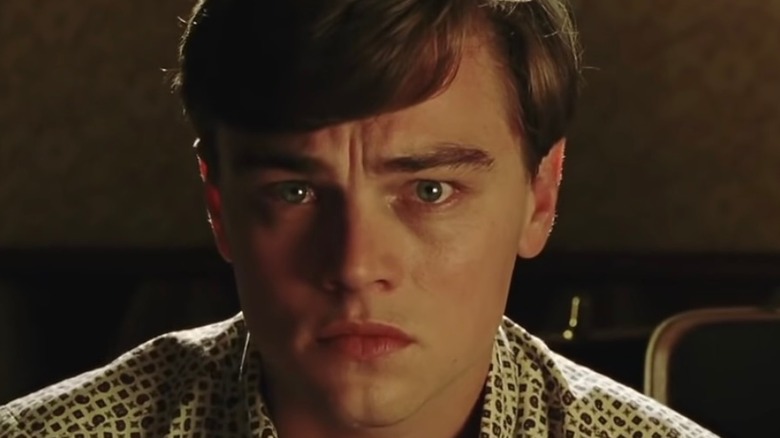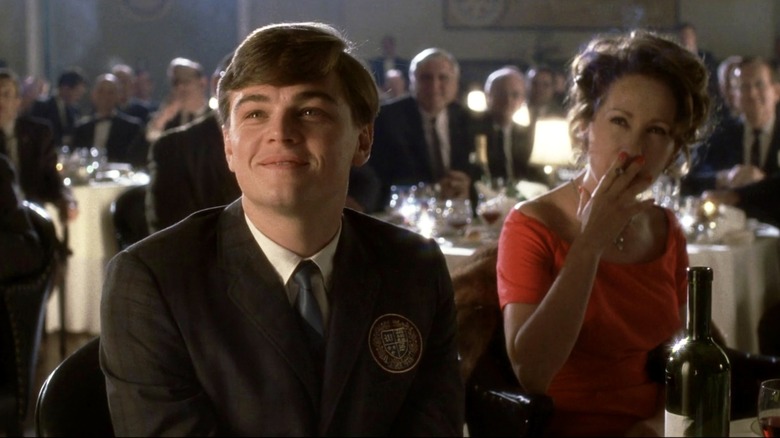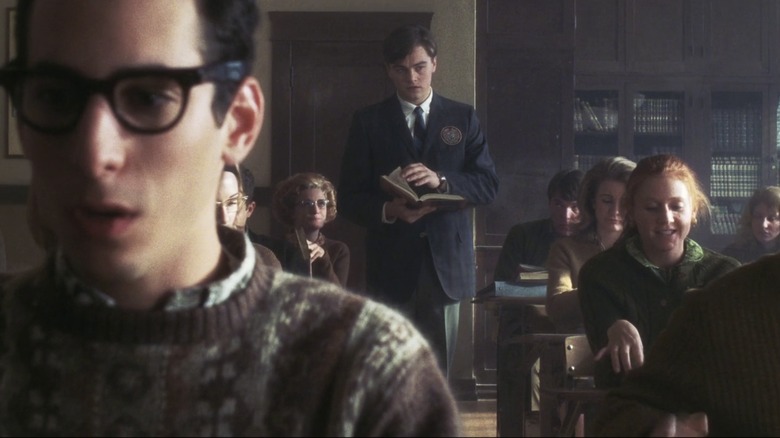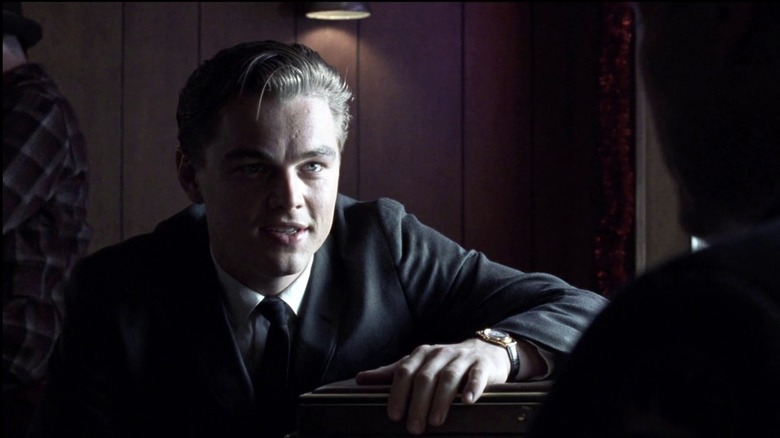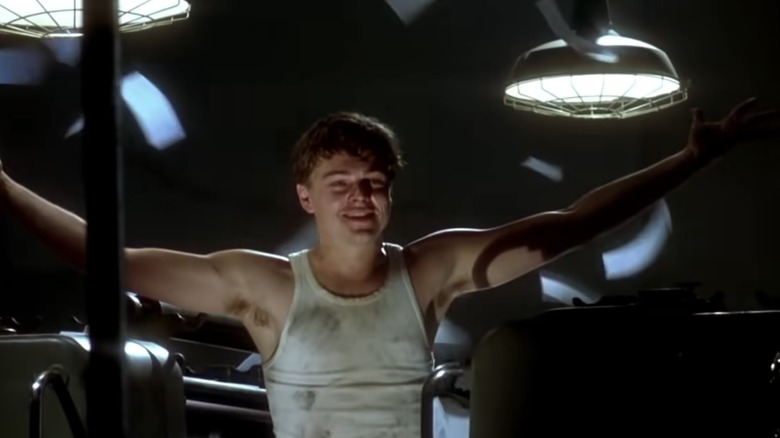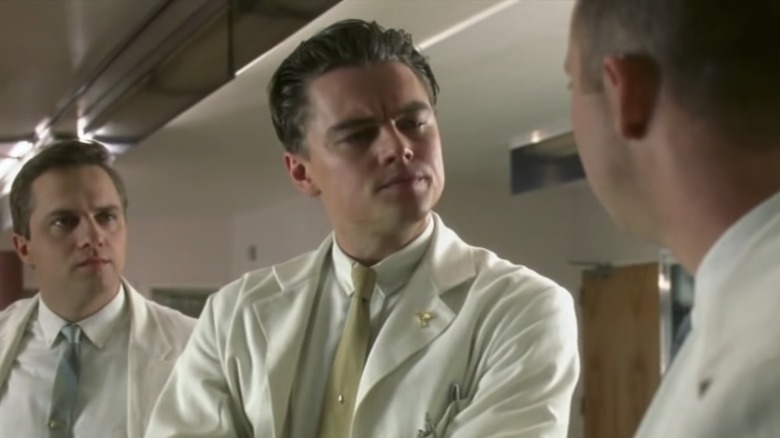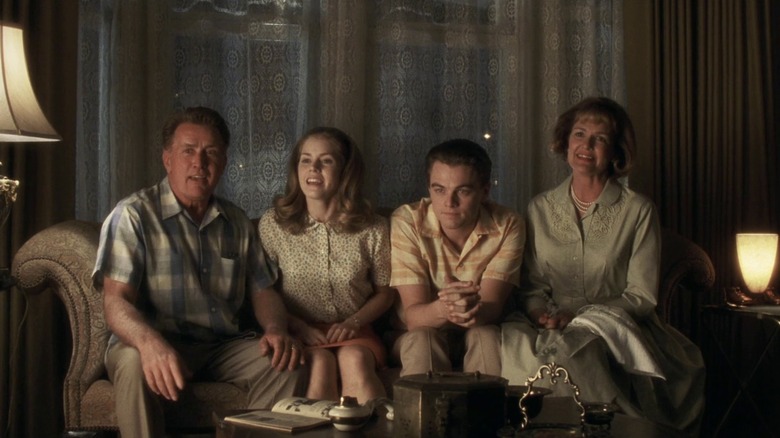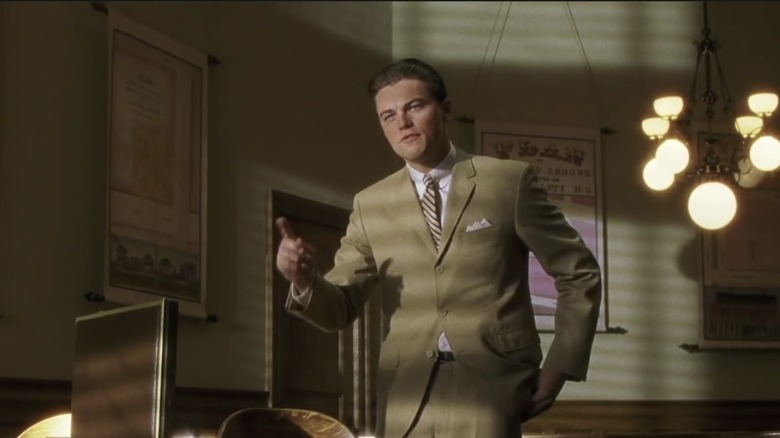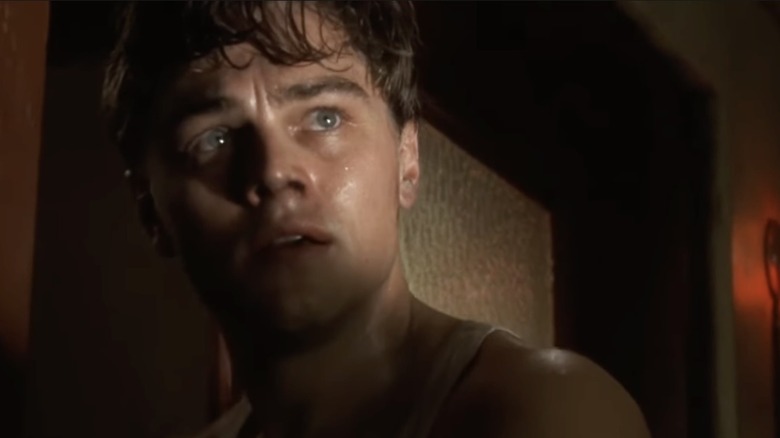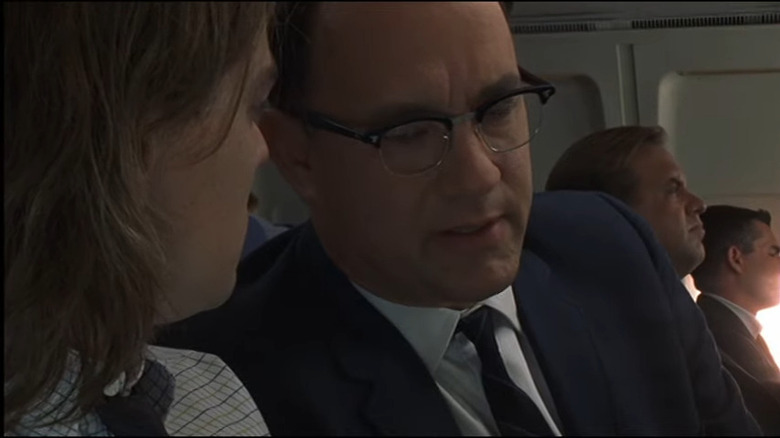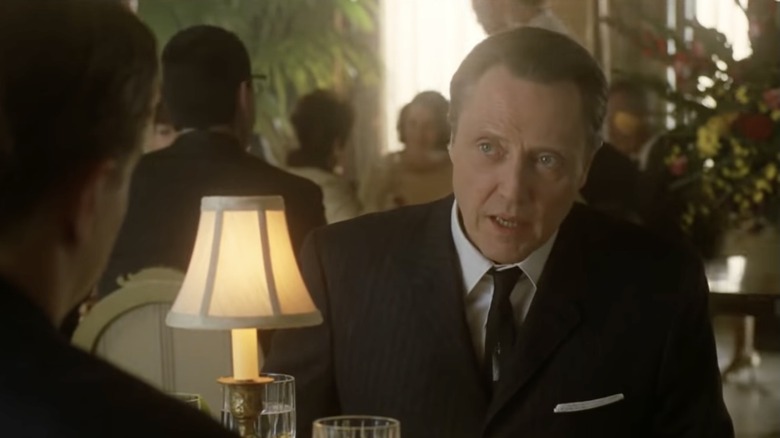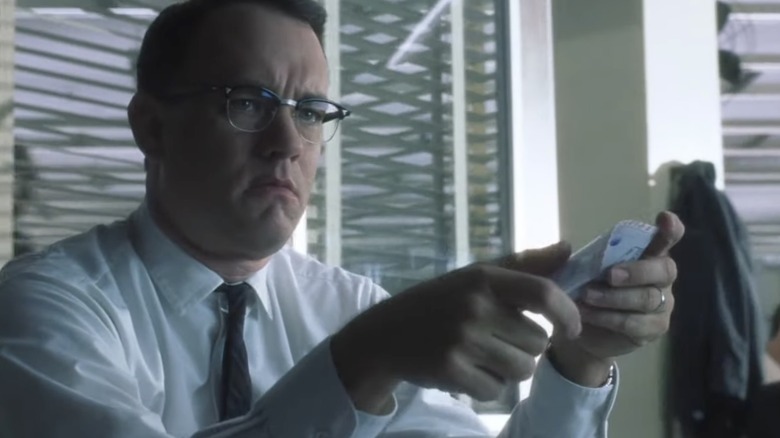Everything Catch Me If You Can Doesn't Tell You About The True Story
Steven Spielberg's film adaptation of the memoir "Catch Me If You Can" is a wild ride that explores the life of con-man and check fraudster Frank Abagnale Jr. While the film was made in good faith and only claims to be inspired by the book, the veracity of Frank's story have been disputed by journalists as early as 1978 and are still being refuted 20 years after the film was released.
Abagnale's 1980 memoir was ghost-written by crime reporter Stan Redding and, as reported by the Los Angeles Times, contains a disclaimer, stating, "This book is based on the true-life exploits of Frank Abagnale. To protect the right of those whose paths have crossed the author's, all of the characters and some of the events have been altered, and all names, dates and places have been changed." Abagnale wrote on his website at the time of the film's release that he was only interviewed four times by Redding and that the story was dramatized in the manner the editor wanted.
The timeline was further altered and condensed by screenwriter Jeff Nathanson, who stated, "I don't know if anyone will ever know the actual truth." A sentiment echoed by Abagnale himself when he told the Los Angeles Times, "Basically, I felt the movie was more accurate than the book, but in the final analysis only I really know." Join us while we parse out everything "Catch Me If You Can" doesn't tell you about the true story.
Frank wasn't an only child
In Spielberg's film adaptation of "Catch Me If You Can" Frank Abagnale Jr. (Leonardo DiCaprio) is an only child. However, the real Frank Abagnale Jr. had two brothers and a sister in real-life, as he stated in an interview with Wired. He was the third child born in the family (via Biography), and Abagnale was portrayed as having siblings in the memoir. Why he is an only child in the film is a bit of a mystery, but this was an intentional choice by the scriptwriter, Jeff Nathanson.
One might surmise this choice was made to emphasize Abagnale's distress at his parents getting divorced and his family disintegrating. If he had siblings, Abagnale might have felt tied to his larger family and less likely to roam the world posing as a Pan Am pilot. This streamlining of the family may have been done to eliminate extraneous characters, therefore simplifying the production of the movie. Regardless of the reason, this is a striking difference between the true story and the film.
Frank's first victim was his father
Unlike in the film, Frank Abagnale Sr. (Christopher Walken), and his wife, Paula Abagnale (Nathalie Baye), separated when Frank Jr. was 14. After his parent's divorce, young Frank lived with his father. During this time, Frank Jr. began using his father's credit card to pay for items he couldn't afford.
Frank Sr. discovered the dishonesty when he received the bill. In this initial instance of Frank misusing credit, he charged upwards of three thousand dollars to his father's card. After being caught, Frank was sent to a school for wayward boys and set out on his own after this experience when he was 16-years-old (per the Los Angeles Times).
Although this betrayal of his father is left out of the film, we get a hint of the duplicity Frank Jr. is capable of when he transfers to a public high school in New York City, posing as the substitute French teacher on his first day of class. This interlude posing as a French teacher may also be a subtle reference to the time Frank purportedly spent posing as a sociology professor at Brigham Young University in Utah, which is an interlude from the memoir that was left out of the film (per The Salt Lake Tribune).
Frank tried to find honest work after running away at 16
As relayed in a talk Frank Abagnale gave at Google, he tried to find honest work when he first ran away from home at 16. However, Abagnale was frustrated by how little he was paid at his minimum-wage job as a 16-year-old high school dropout. Abagnale was tall and prematurely gray, so he started saying he was a decade older, hoping to make more money. The money still wasn't enough for the lifestyle he wanted to live, and he began passing bad checks from his checking account (per the Los Angeles Times).
In the book and film "Catch Me If You Can," this is the point at which Abagnale notices the deferential treatment pilots are given and hatches his master plan to impersonate a pilot to cash fraudulent checks. The expose "The Greatest Hoax on Earth: Catching Truth, While We Can," released in December 2020 and written by journalist Alan C. Logan, disputes both the time frame and extent of Abagnale's success in posing as a pilot and at cashing fraudulent checks.
Although journalists have been investigating Abagnale's claims for decades, Logan's book is the most exhaustive investigation into Abagnale's life and the discrepancies between the book written by Redding. One of the more astute points made about this expose is highlighted by San Franciso Book Review, which writes, "It's not even clear how much of that con was Abagnale's own work since it seems more in keeping with the style of Stan Redding, the coauthor of the original 'Catch Me If You Can.'"
Frank's fraud crimes may have been exaggerated
In "Catch Me If You Can" Frank Abagnale Jr. claims to have passed millions of dollars in forged payroll checks while posing as a Pan Am pilot during the late '60s, but he was only charged with several counts of forgery and theft before being sentenced to 12 years in prison in the U.S. As reported in an article by the Daily Mail, the nonfiction book "The Greatest Hoax on Earth: Catching Truth, While We Can" suggests Abagnale's stint impersonating a Pan American pilot only lasted a matter of months, rather than years as it was portrayed in the memoir and film. Logan, the author of this expose, maintains the forged Pan Am checks totaled less than a measly $1,500.
The interesting thing about Abagnale's story is everything transpired long before the invention of the internet. As such, his incredible adventures have built into a folk hero type of tale over the years. In fact, there is very little substantiated evidence to support his claims. However, like a snowball, the stories grew, slowly taking on a life of their own every time they were told. Shows like "To Tell The Truth" and "The Tonight Show" took Abagnale at his word, while investigative journalists like Stephen Hall with The San Francisco Chronicle began debunking Abagnale's story as early as 1978, after Abagnale's appearance on "The Tonight Show" (per WHYY).
A book questions if Frank's claims of posing as a doctor are true
"The Greatest Hoax on Earth: Catching Truth While We Can" dispels many of the claims presented in Frank Abagnale Jr's memoir and later in Spielberg's film. Although Abagnale's book has the disclaimer acknowledging some occurrences have been changed, Logan suggests most of Abagnale's fantastic tale is fabricated.
Logan developed a very persuasive timeline for his book, suggesting Abagnale couldn't have done everything in "Catch Me If You Can" because he was in jail for most of the time he was allegedly on the run (via Daily Mail). From this timeline, supported by public records and newspaper clippings, we can see that much of the period Abagnale was allegedly posing as a doctor in Georgia, he was reportedly serving time in the Great Meadow Correctional Institute in Comstock, New York. He was only paroled briefly in 1967, which was after the period he was allegedly posing as a doctor in Georgia.
Mark Zinder, Abagnale's former booking agent, told Daily Mail, "No one wanted to ruin the story," summarizing his statement from Logan's book where Zinder stated, "The guy has no conscience, he was still telling bald-faced lies. And the media weren't interested in veracity. And that just enabled and emboldened him more." When the Daily Mail reached out to Abagnale for comment on Logan's book, Abagnale replied via email with the statement, "I have not read the book, nor do I think it is worthy of a comment."
Brenda doesn't exist in real life
Brenda the candy striper, played with sweet vulnerability by Amy Adams in Spielberg's movie, doesn't exist in real life. Abagnale wrote on Broadway, "The character of Brenda Strong is based on an Eastern Airlines flight attendant I dated while living in Louisiana, which fit into the story Spielberg wanted to tell about my life between the ages of 16 and 21. We were never engaged, as I was too young to even think about that."
The information provided by Alan C. Logan in his nonfiction book suggests this character might be based on Paula Parks, a Delta Airlines flight attendant. Allegedly, Abagnale stalked Parks to her home state of Louisiana, charming his way into the lives and home of Parks' parents in Baton Rouge. As reported in a Daily Mail article about Logan's book, Abagnale allegedly moved in with the Parks family briefly at the beginning of 1969 before being arrested for theft and forgery in Baton Rouge in February 1969.
In an interview with The Irish World, Logan said, "He [Abagnale] was also convicted of stealing from a local family and he was facing 12 years in the State Penitentiary in Louisiana. But he was treated lightly. But in any case, Abagnale, already a recidivist at this point, was given the 12 years as probation and psychiatric treatment. Instead he fled to Sweden and France."
Abagnale's claims he passed the bar and worked as a lawyer in Louisiana might not be true
Frank Abagnale Jr. claims to have passed the bar on his third try and worked as a lawyer in Louisiana. However, officials at the Baton Rouge office where Abagnale allegedly worked say he is lying. In a 1981 article titled "Great Imposter" from Baton Rouge's State-Times an ex-attorney general labeled the story "absolutely untrue and preposterous."
A takedown of Abagnale's outlandish claims by journalist Ira Perry for The Daily Oklahoman in 1978 says, "The fifth floor of the Louisiana office building where Abagnale says he worked as an assistant state attorney general without a law degree has never housed the agency's offices." This, like many other details, suggests the entire story was fabricated. Perry suggests much of what Abagnale claims is used to "bolster a million dollar business based on his professional knowledge as the king to tricksters."
"The Greatest Hoax On Earth: Catching Truth, While We Can" also questions the veracity of Abagnale's claim that he was a lawyer in Louisiana. In the timeline from the book shared by Daily Mail, we see Abagnale was reportedly imprisoned in Comstock, New York when he was allegedly posing as a lawyer in Louisiana. Considering how in the film, Abagnale's time in Louisiana is connected to his relationship with Brenda, who doesn't exist, suggests this entire interlude of the film is questionable despite having been inspired by the memoir.
In the film Frank first arrest is in France, but that's not what really happened
Frank Abagnale Jr. was arrested multiple times before he was apprehended in France in October 1969 (per Daily Mail). He had already done a significant stint in prison before fleeing to Europe, according to journalist Alan C. Logan's book debunking Abagnale's wild stories.
Abagnale was arrested in Eureka, California with a stolen car in June 1965, making the local paper, Eureka Humboldt Standard. As reported by The Herald Statesman, a month later the 17-year-old was arrested in Tuckahoe, New York, and charged with forgery of a $350 check he allegedly stole from a service station to pay for a trip to Florida. These arrests resulted in Abagnale being confined to the Great Meadow Correctional Institute starting in July 1965. He was briefly paroled in 1967 but then sent back until December 1968 (per Daily Mail).
After being arrested and jailed in Baton Rouge in February 1969, Abagnale was released on parole in June of the same year before absconding to Europe, where the film finally depicts Abagnale being arrested by FBI agent Carl Hanratty (Tom Hanks) for the very first time. However, it was French authorities that arrested Abagnale for theft and swindling after an airline stewardess recognized him and alerted Interpol that Abagnale was in France. Abagnale's arrest led to him spending time in a French prison before being sent to a prison in Sweden, which was accurately depicted in the film.
Frank did escape the plane bringing him back to America, but it wasn't through the toilet
While returning to the United States, Frank Abagnale Jr. escaped hoping to avoid being handed over to the FBI and standing trial for his crimes. However, his claims about how he escaped the plane have changed over the years. A 1978 article reported Abagnale escaped the plane through a hatch below the toilet, as is depicted in the film. By 2002, when the movie came out, Abagnale said he exited through the kitchen galley of the plane, as confirmed in an interview Abagnale did with Wired.
Abagnale was not accompanied by FBI agents on the plane as depicted in the film but was instead to be remanded to FBI custody at the airport in New York. Abagnale was reportedly arrested in Montreal, Canada, after escaping the plane, not in front of his mother's house as was depicted in the film.
After a second escape, Abagnale posed as a pilot, interviewing college girls for a fictitious flight attendant program, as reported by the Arizona Daily Star. After that, Abagnale was arrested in Georgia in November 1970 for check fraud. The extent of his criminal activity during this time has been disputed by Ira Perry with The Daily Oklahoman in 1978 and later by Alan C. Logan. In his book, Logan maintains Abagnale forged only 10 Pan Am checks totaling $1448.60 rather than millions as depicted in the film (per Daily Mail).
Frank never saw his father again after running away at 16
Frank Abagnale Sr. didn't die before his son was brought back to America from Sweden, as was depicted in the film. However, Frank Sr. died before Frank Jr. was released from the Virginia prison where he served time. Frank Jr. never saw his father again after running away at 16. In a speech Abagnale gave at Google, he talks about his experiences as a young man. Regardless of whether you believe Abagnale's version or what Alan C. Logan lays out in his nonfiction book, one thing is abundantly clear — Abagnale regrets never seeing his father again. Abagnale speaks about his father with warmth, casting Frank Sr. in a positive light, emphasizing he was a loving father.
This might be why Abagnale has responded so warmly to Spielberg's "Catch Me If You Can." In the film, Abagnale visits his father repeatedly during the years he was on the run. In an interview with IGN, Spielberg addressed this discrepancy, saying, "When Frank ran away from home, he never saw his father again. And I wanted to continue to have that connection where Frank kept trying to please his father; by making him proud of him; by seeing him in the uniform, the Pan-American uniform."
Jeff Nathanson, the scriptwriter for the film, said, "There are, of course, different kinds of truths" (via Wausau Daily Herald). This film revealed Abagnale's emotional truth — that he was a lonely kid who never got to see his father again and wished he had. Abagnale told The Wausau Herald, "It was a more serious film than I thought it would be. And a lot more accurate."
Tom Hanks character is a fictional composite based on multiple FBI agents
The cat-and-mouse game between Carl Hanratty and Frank Abagnale Jr. is one of the most engaging aspects of "Catch Me If You Can." However, this is an invention of the scriptwriter. The FBI agent Tom Hanks plays in the film doesn't exist. In the memoir "Catch Me If You Can," the arresting FBI agent is Sean O'Riley, while in real life the arresting FBI agent in Georgia was Joseph Shea. In a speech at Google, Abagnale said, he and Shea became friends after Abagnale was released from prison.
Abagnale also didn't call Hanratty every Christmas, as was depicted in the film. Abagnale didn't meet the FBI agent looking for him in real life until Shea arrested Abagnale in Georgia in 1970. This relationship was a narrative device created for the film to establish a friendship between Frank and the FBI agent, making Hanratty a father figure for the young felon.
Interestingly enough, one of Abagnale's sons became an FBI agent. Abagnale told Wired, "My proudest moment was probably when my oldest boy finished law school and went on to become an FBI agent. It was just beyond my imagination that -– with my background -– my own son would become an FBI agent."
Regardless of where you stand on the veracity of Abagnale's wild stories, Spielberg's film is an enjoyable movie, with excellent performances by DiCaprio, Hanks, and Christopher Walken. Walken was even nominated for an Oscar for his supporting role, and the film has outstanding ratings on Rotten Tomatoes.
